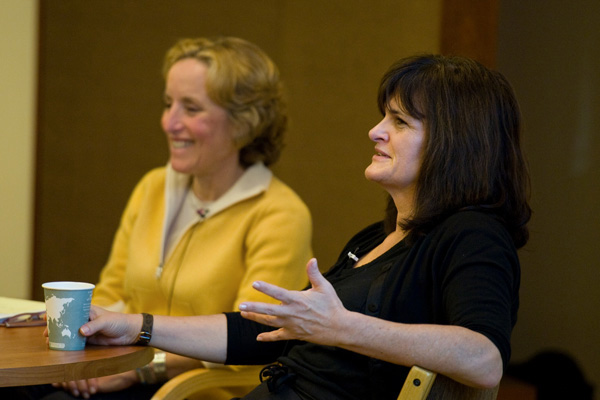The Times' fashion critic talks about the business
Cathy Horyn began as an AP copy girl in Chicago; now she's one of the world's leading fashion critics. But with globalization, Twitter feeds and live streaming, "The system is overloaded," she says.
For a fashion critic sitting by the catwalk, there are no crib sheets, no introductory notes, no labels, no explanatory context for the clothes the models are wearing as they pass by – it's the visual equivalent of a cold call each time. Nonetheless, you have to file a story, and quickly.
That's the world of Cathy Horyn, fashion critic of the New York Times for over a decade, and the blogger behind "On the Runway." She came to tell Stanford about her world and "the basic archaeology of clothes" in a conversation with Nancy Troy, professor and chair of art and art history at Stanford and author of Couture Culture: A Study in Modern Art and Fashion.
"You have to be a good observer. Have to use your eyes. It's all in front of you. You have to report what you see," Horyn said.
"How do you compete with 13-year-old blogger?" she asked. "In order to be the critic, you have to know what you're doing. You don't become a critic overnight."
"You have to be a reporter and go backstage," she said. "You try on the clothes to see if they're actually wearable."
Beyond watching what's in front of you, critics make choices when they write. "Do you report the conformity, or being different?" she said, noting that modern fashion ranges along this spectrum.
Horyn is this quarter's visiting Arts Critic in Residence; the program is sponsored by the Stanford Humanities Center and the Stanford Institute for Creativity and the Arts (SiCa).
A relatively new discipline
The decision to invite her was something of an edgy one. As Horyn herself admitted, "Fashion criticism is a relatively new area of criticism. It doesn't get a lot of respect."
"The title 'fashion critic' wasn't invented until 1993 or 1994," she said.
The fashion world, as well as journalism, is a highly volatile environment, transmogrified by the Internet. With laptops, Twitter feeds, live streaming of shows and an insatiable online demand for more material faster, "Everything gets so immediately consumed and exposed," she said.
Horyn pointed out that, in the 1970s, fewer designers held the field, and everyone knew who they were. Now, with a confusing army of designers, an onslaught of shows and globalization, "You have an audience that's more critical. They want more of a sense of selection, more 'tell me why this matters.'"
During the last round of Paris shows, she produced "twenty-four different pieces of writing over an eight-day period." In blog posts, reviews and audio scripts for slideshows, "I barely had time to think what I wanted to say."
As time goes on, she said, she finds she is becoming more and more "anti-commerce." With the overkill number of shows everywhere, in every nation of the world, and live streaming allowing viewers to order online what they see, fashion has been globalized and commercialized in a way that squelches creativity. "The system is overloaded," she said.
Maybe it's time for a rethink, she suggested. "Maybe I should just not go to shows anymore. Maybe it's getting boring, being locked in with everyone in the same pen. Maybe I need to be more of a reporter … as a way of distinguishing us, as a way of slowing it down."
An early blogger
Notwithstanding her concerns about the immediacy of the Internet world, Horyn was among the early adopters of the fashion blog form in 2007. She said she had been toying with the idea of doing a blog, an idea that came to her while watching the Emmy Awards. "I needed a place to write all the silliness that you see," she said; for example, "How can you describe the implants in Charlie's Angels' faces?"
She was intoxicated by "the kind of instantaneity of it, a certain idea of it as less-formal writing." After she learned the technical rudiments, it was a heady experience to post directly online at any time from Paris, eliminating the wall between the writer and the public.
The early days of blogdom were exhilarating and inventive: "No one knew what a blog should be," she said. "No one of the higher-ups was saying, 'You must do it like this.'"
She recalled writing posts that were "very stream-of-consciousness."
"The traditional readers of the Times were horrified at the form. But this is what a blog can be: personal and detailed and you're not very neat about it."
Blog posts "can be fast and short and dirty and funny."
Ironically, given her early wish to write about the silliness, "Very quickly we amassed a lot of regulars who wanted to take fashion very seriously."
Horyn began her career as a copy girl for the Associated Press in Chicago and then as a reporter on the Virginia Pilot in Norfolk. In a post-Watergate world where suddenly everyone wanted to be a journalist, Horyn distinguished herself in the niche of fashion, with "the freakiest of freakish people."
Speaking at informal noon discussion Oct. 20, Horyn recalled when Grace Mirabella, former editor-in-chief of Vogue and founder of Mirabella magazine, told her, "You write like a sports writer." Horyn compared herself instead to literary critic Edmund Wilson, writing about Proust and the Symbolist poets: "He saw the heroic aspects and virtues of what they were trying to do.
"What happens to the form itself is much more of a critical issue now. As things get thinner and thinner, with less and less substance, there's less and less history and memory in it. That's my great fear about fashion: I'll have to write about the clothes."


Share This Story